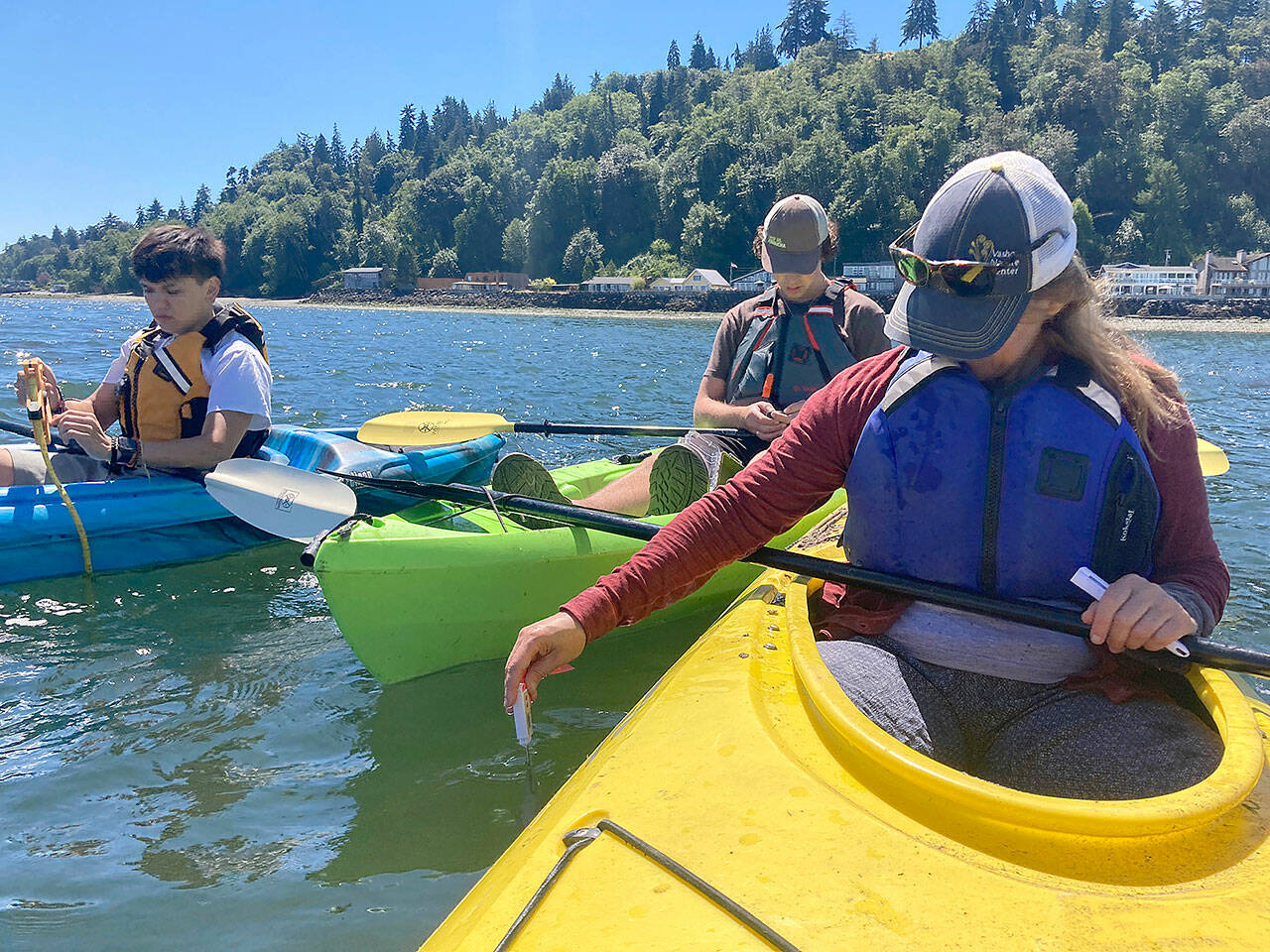On a recent summer day, the sun glittered off the crisp Puget Sound waters.
While exploring a resilient kelp forest off the north point of Vashon Island near Colvos Passage, a harbor seal and her pup popped their heads above water, glancing at Vashon Kelp Forest project survey volunteers in their brightly colored kayaks, before slipping back into their underwater home.
Like many in Puget Sound, the kelp forest, a once-thriving underwater ecosystem, is now nearly non-existent. But what remains is worth saving.
“It shows this is a seaweed habitat that these animals love and need, and us keeping it and/or bolstering it would be huge,” said Michael Kollins, an island resident and founder of the Vashon Kelp Forest project. The project’s goal is to research and help regrow kelp forests near Vashon’s shoreline.
Kollins worked in finance overseas in Europe and Asia before shifting careers to nonprofit work. He and his wife purchased their home on Vashon overlooking the water about seven years ago, splitting their time living between Seattle and the island.
After observing the kelp forest from his home and learning more about declining kelp forests in Puget Sound, Kollins set out to save remaining kelp forests near Vashon.
“The biggest thing for me is proving that this works, if it does work, and figuring out what the positives of it are,” Kollins said. “No one seems to have done surveys of these bull kelp beds around Vashon in many, many years.”
On July 15, project volunteers and Vashon Nature Center staff and interns conducted a kayak survey to create baseline data about Vashon’s kelp forests in the possible project area.
“This exact same research is being done elsewhere,” said Maria Metler, education programs manager for the Vashon Nature Center who participated in the survey. “We wanted to make sure we were able to document what was here and how the Vashon Kelp Forest project affects that [in the future] through monitoring.”
After an overview presentation of kelp ecology, as an ecological restoration tool and an economic resource, by grad student Maite Gatos-Fuentes, surveyors paddled out. One kelp bed to the north end of Vashon and another kelp bed southwest corner of Blake Island were analyzed.
The group split into two teams and worked to plot the exterior boundaries of the kelp forest, and documented where they found the thickest density of kelp. Temperature and depth were also recorded.
“It’s in gorgeous condition, there’s a lot of life out there,” Metler said of the diverse seaweeds and sealife.
The kayak survey found the northern kelp bed, near the Vashon ferry dock, was larger and more dense in parts than the site near Blake Island, according to the summary document. Both sites had bull and sugar kelp.
In the south Puget Sound, 80% of bull kelp has been lost in the last 50 years, according to the Puget Sound Restoration Fund. Almost all bull kelp disappeared near Bainbridge Island within the last decade.
As kelp forests are disappearing from Puget Sound waters, Vashon’s northern kelp forest is an anomaly, Metler explained.
“We’re hopeful that just with knowledge we can, if nothing else, maintain its existence,” she said.
Kollins’ goal is to host several kayak surveys prior to launching the project in order to produce comparison data.
Permits to establish the project have been submitted, needing approval from the Army Corps of Engineers, the Department of Natural Resources (DNR) and King County.
The permits ask for allowance to lease a section of water off the coast of Vashon Island. Or, as Kollins explains, King County issues the permit and DNR leases the water.
If, or when, approved, anchors will be placed on the seafloor with buoys marking the perimeter of the discovered kelp forest. Seaweed seed will be purchased from the Puget Sound Restoration Fund and planted in the area. The project is working primarily with sugar kelp, to be harvested for sale, and bull kelp, to be grown for restoration.
Kelp grow in a typical crop cycle as an annual species. Most of the kelp will be left in the water, with hopes that reproductive spores will drift and revitalize other nearby kelp beds.
This underwater farmland is similar to growing wheat, he said. No fertilizer, tractors or other equipment needed.
“Once you start the process … you just wait for the sun to [help it] grow,” he said.
Defining the project in terms of what it isn’t is helpful to alleviate neighbors’ concerns, he added. There are no cages or nets planned, nor any permanent seafloor equipment. No noise and no restriction of recreational use.
“I want people on Vashon to view this project as a Vashon thing, not ‘Mike’s thing,’” he said. “The farming’s not the focus; the restoration is the focus. And that’s really for the community.”
While waiting on the permits, the next several months consist of working with possible research partners and continuing monthly surveys. The goal start date for the Vashon Kelp Forest project is early 2023.
“Even if we prove that [this project] doesn’t help, it would be good to know because nobody knows,” he said. “But if it does help, that would be great.”
For those interested in learning more about the Vashon Kelp Forest project, volunteering for a kayak survey or attending a meeting, visit vashonkelpforest.com.


